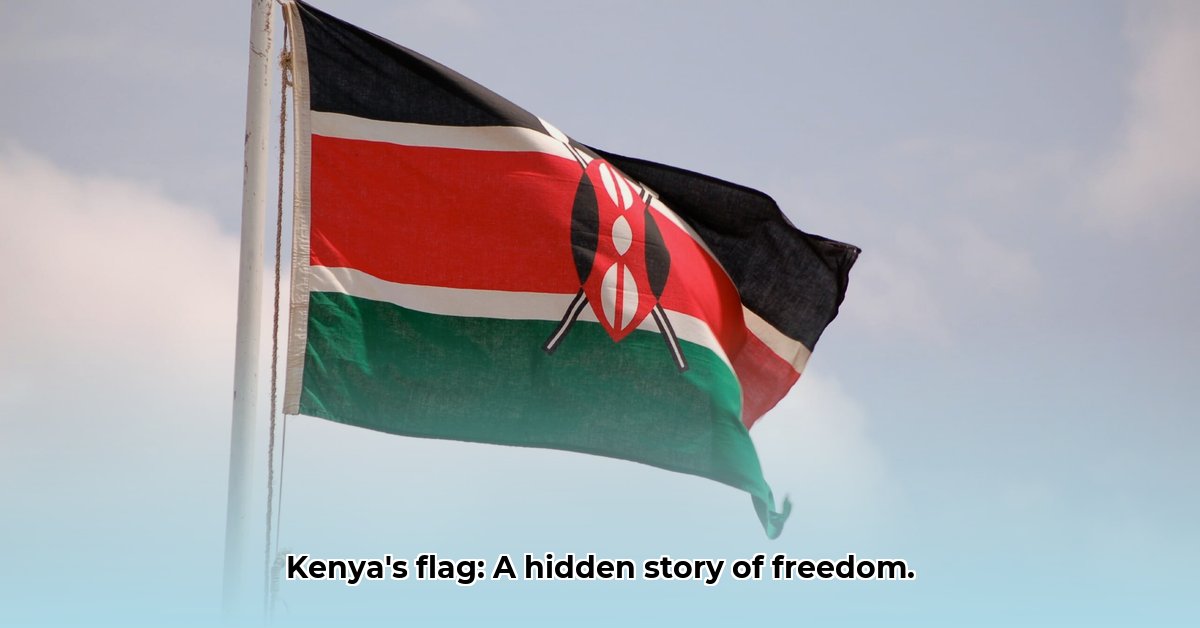Kenya’s flag is more than just a collection of colors; it’s a potent symbol that encapsulates the nation’s journey towards freedom and unity. For comparison, see the Kentucky flag. This article delves into the history behind the flag’s design, exploring its colors and images. We will uncover the meaning embedded in the black, red, and green stripes, and examine the importance of the Maasai shield and spears. This exploration will highlight how the flag embodies the country’s fight for independence and its aspirations for the future. We’ll explore the individuals and events that have shaped this symbol of Kenyan national identity, reflecting cultural diversity and political compromise.
The Flag of Kenya: A Symbol of Unity and Freedom
Adopted on December 12, 1963, the Kenyan flag represents the country’s path to independence and its aspirations. It tells a story of struggle, sacrifice, and the ongoing effort to build a unified nation, reflecting aspirations for peace and resilience. Let’s explore the flag’s design and uncover the history behind this emblem.
A Nation’s Colors: Symbolism
The Kenyan flag showcases a tricolor design that includes black, red, and green horizontal stripes, enhanced with white borders. Each color holds significance. The black stripe represents the Kenyan people. The red stripe serves as a reminder of the sacrifices made during the fight for independence. The green stripe symbolizes Kenya’s lands and natural resources.
The white borders symbolize peace and unity, a message for a nation striving for harmony after colonial rule. The colors represent a promise of a peaceful future.
Symbolism of the Shield and Spears: Strength and Heritage
Dominating the center of the flag is a Maasai shield and two crossed spears, which represent the strength and heritage of the Kenyan people. This symbol signifies the nation’s defense of its sovereignty. The Maasai imagery symbolizes uniting different cultural groups. It represents the country’s cultural diversity.
A Flag Forged in Negotiation
The Kenyan flag’s creation involved negotiations between factions. The Kenya African National Union (KANU) played a role. The design, including the Maasai shield and spears, demonstrates a balance between political maneuvering and cultural representation. The flag reflects discussions about Kenyan national identity and cultural representation. Tom Mboya, a leader of the Kenyan African Democratic Union (KADU), played a crucial role in the final design.
A Living Symbol: Evolving Interpretations
While the interpretations of the Kenyan flag are widely accepted, differences exist. Variations in color shades and interpretations can change over time, reflecting cultural shifts and societal perspectives. The flag’s meaning is dynamic, evolving with the Kenyan people’s story, allowing for an ongoing discussion about Kenyan national identity.
Looking Ahead: A Symbol that Endures
The Kenyan flag remains a symbol of national identity, reminding people of the fight for freedom and the pursuit of unity and prosperity. Connecting the past, present, and future, it symbolizes hope, resilience, and the Kenyan spirit. As a symbol worth cherishing and understanding, it inspires and unifies.
Reproducing Kenyan Flag Colors
Reproducing the Kenyan flag with accuracy requires attention to detail, concerning its colors and their symbolism.
Key Takeaways:
- The Kenyan flag’s colors—black, red, green, and white—symbolize the nation’s identity and aspirations.
- Understanding the flag’s historical context enhances appreciation for its symbolism.
- Accurate reproduction requires precise color specifications and attention to detail.
- Prioritize reliable color codes for accurate Kenyan flag colors.
The Kenyan flag is a symbol of national pride, and its colors and imagery tell a story of struggle, unity, and hope. Understanding how to accurately reproduce its colors is essential for representing this symbol.
Symbolism of Precise Shades
Black represents the Kenyan people; red symbolizes sacrifices for independence; green represents agriculture and natural resources; and white stands for peace and unity. The Maasai shield and spears represent the defense of freedom and national sovereignty.
The Challenge of Color Accuracy
Discrepancies exist in the color codes (HEX, RGB, CMYK) used to recreate the flag due to digital reproduction versus physical printing, dye lots, and pigment formulations. These variations impact the representation of national pride.
Achieving Faithful Reproduction: Step-by-Step
To accurately reproduce Kenyan flag colors, follow these steps:
- Source Reliable Information: Seek sources such as government websites or heraldic authorities for standard color specifications.
- Choose Your Medium: Base your color reproduction method on whether you are printing or creating a digital version.
- Use Specific Color Codes: Use the precise HEX, RGB, or CMYK codes from your reliable source.
- Color Calibration: Calibrate your printer to ensure colors are reproduced faithfully to the specifications, especially for printed versions.
- Testing and Adjustments: Compare a test version to a reliable image of the Kenyan flag to identify and correct discrepancies.
Taking these steps will ensure the closest possible representation, honoring the embedded symbolism.
The Kenyan Flag: Evolution of Design and Symbolism
Understanding the evolution of the Kenyan flag helps in appreciating its depth and significance as a national symbol.
Key Takeaways:
- Adopted in 1963, the Kenyan flag symbolizes the nation’s journey to independence and unity aspirations.
- Its design blends Pan-African ideals and Kenyan imagery.
- The flag’s colors and symbols represent the people, sacrifices, natural resources, and pursuit of peace.
- The flag has become a unifying symbol for Kenyans.
- Ongoing discussions about symbolism shape national identity.
A Tricolor: Colors and Meanings
The Kenyan flag is a visual narrative of Kenya’s history and identity and a symbol of aspiration. The black stripe represents the Kenyan people; red evokes sacrifices for independence; and the green band symbolizes natural resources. The white border symbolizes peace and unity.
This design builds upon the legacy of the Kenya African Union (KAU), speaking to the changing political landscape and national identity.
The Shield and Spears: Heritage and Defense
The flag features a Maasai shield and two crossed spears, embodying Kenya’s cultural heritage and commitment to defense. Representing the Maasai community highlights the importance of indigenous cultures. The spears symbolize the nation’s resolve to protect its sovereignty.
Unity Through Time
The creation of the Kenyan Flag involved debate and interpretations, reflecting the complexities of Kenya’s post-colonial era. The flag became a point of shared pride and national unity.
A Symbol of Aspiration
The Kenyan flag represents national aspirations for prosperity, progress, and peace. It reminds people of past sacrifices and the responsibilities of building a better future, connecting Kenyans across diverse backgrounds and identities. As a unifying force, it reminds Kenyans of their shared national identity and goals.
Pantone Color Specifications in the Kenyan National Flag
The lack of standards creates a challenge for accurate reproduction.
The Kenyan flag, a vibrant symbol of national pride, boasts colors, each carrying symbolic weight. But have you wondered about the shades used or the accuracy of Pantone Color Specifications in the Kenyan National Flag?
Decoding the Colors: Symbolic Meanings
The symbolic meaning of each color is agreed upon. Translating these into color codes proves complex, leading to challenges in accuracy.
Different sources offer varying numerical representations for flag colors (HEX, RGB, and CMYK). This variation stems from difficulties in color space conversion and the lack of a standard. How can the Kenyan flag be consistently reproduced without a unified standard?

![[Facts about Kenya Food]: A Culinary Journey Through Kenya's Diverse Flavors Facts-about-Kenya-food_2](https://www.lolaapp.com/wp-content/uploads/2023/12/Facts-about-Kenya-food_2-150x150.jpg)














